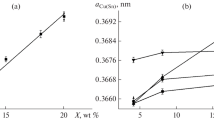Abstract
Bronzes with an enhanced (14 wt %) tin content which were alloyed with titanium, zirconium, and boron have been studied in the as-cast, homogenized, and deformed states by scanning and transmission electron microscopy and X-ray diffraction analysis. These alloys are of interest as a matrix material for superconducting Nb/Cu-Sn composites in which the high tin content and the alloying of the bronze matrix make it possible to improve superconducting characteristics at the expense of optimization of the structure and properties of layers of the Nb3Sn compound formed at the niobium-bronze interface via reactive diffusion. The distribution of alloying elements in different states of the bronze has been investigated. It has been shown that Zr is uniformly distributed in the alloy and forms no coarse inclusions, whereas Ti forms in the as-cast state large platelike precipitates that can adversely affect technological characteristics of the bronze matrix and the composite as a whole.
Similar content being viewed by others
References
Y. Tanaka, “The Forefront of Practical Superconducting Wires,” Physica C 335, 69–72 (2000).
A. Shikov, A. Nikulin, A. Silaev, et al., “Development of the Superconductors for ITER Magnet System,” J. Nucl. Mater. 263, 1929–1934 (1998).
H. Sakamoto, M. Higuchi, S. Endoh, et al., “Very High Critical-Current Density of Bronze-Processed (Nb,Ti)3Sn Superconducting Wire,” IEEE Trans. Appl. Superconduct. 10(1), 971–974 (2000).
D. S. Holmes and A. M. Adair, et al., “Bronze for Superconducting Wires: The Powder Metallurgy Approach,” IEEE Trans. Magn. MAG-17, 1010–1012 (1981).
E. N. Popova, L. A. Rodionova, S. V. Sudareva, et al., “Influence of Different Deformation Techniques on the Structure of Bronze Matrix of Multifilamentary Nb3Sn Composites,” Fiz. Met. Metalloved. 76(2), 144–152 (1993) [Phys. Met. Metallogr. 76, 228–234 (1993)].
P. C. J. Gallagher, “The Influence of the Alloying Temperature and the Related Effects on the Stacking Fault Energy,” Metall. Trans. 1(9), 2429–2461 (1970).
D. Liu, A. Miller, and K. T. Aust, “Annealing Twin Formation in the Cast and Annealed Cu-4 at. % Sn Alloy,” Canada. Met. Quart 23(2), 237–240 (1984).
A. K. Shikov and A. D. Nikulin, Effect of Alloying of the Materials of Matrices and Filaments on the Critical Properties of Ni 3 Sn Multifilamentary Conductors: A Review (TsNII Atominform, Moscow, 1984), No. 7 (95).
Sh. Ochiai, K. Osamura, and M. Maekawa, “Comparison of Mechanical and Superconducting Properties of Titanium Added Nb3Sn Composite Wire with Those of Non-Added Ones,” Supercond. Sci. Technol. 4(6), 262–269 (1991).
K. Tachikawa, M. Terada, and M. Endo, “An Improvement of Critical Current Density in Bronze Processed Nb3Sn,” Sci. Report Res. Inst. Tohoku Univ., Ser. A—Phys., Chem., Metall. 37(1), 108–115 (1992).
L. A. Rodionova, E. N. Popova, S. V. Sudareva, et al., “Electron Microscopic Study of the Structure of Nb/Cu-Sn Composites with Titanium-Doped Niobium Filaments,” Fiz. Met. Metalloved., No. 12, 100–110 (1991).
E. N. Popova, L. A. Rodionova, S. V. Sudareva, et al., “Titanium Distribution in Different Constituents of Nb3Sn Superconducting Composites,” Fiz. Met. Metalloved. 75(2), 112–118 (1993) [Phys. Met. Metallogr. 75, 189–193 (1993)].
E. N. Popova, L. A. Rodionova, S. V. Sudareva, et al., “Effect of Gallium Addition on the Structure and Properties of Nb3Sn Superconducting Composites,” Fiz. Met. Metalloved. 75(2), 119–124 (1993) [Phys. Met. Metallogr. 75, 194–198 (1993)].
L. A. Rodionova, E. N. Popova, S. V. Sudareva, et al., “Structure and Mechanical Properties of Alloyed Bronze Matrix in Nb3Sn-based Superconducting Composites,” Fiz. Met. Metalloved. 73(1), 93–99 (1992) [Phys. Met. Metallogr. 75, 71–75 (1992)].
E. N. Popova, V. V. Popov, E. P. Romanov, et al., “Effect of Alloying on the Kinetics of the Formation of the Fine Structure of the Nb/Cu-Sn Composites,” Fiz. Met. Metalloved. 81(6), 109–117 (1996) [Phys. Met. Metallogr. 81, 653–659 (1996)].
E. Poggio and P. Piccardo, “Tint Metallography of As-Cast Tin-Bronzes for Hot Tearing Investigation,” Eur. Microsc. Anal., No. 5, 5–7 (2004).
H. Warlimont and L. Delaey, Martensitic Transformations in Copper-, Silver-, and Gold-Based Alloys (Pergamon, Oxford, 1974; Nauka, Moscow, 1980).
L. M. Utevskii, Diffraction Electron Microscopy in Metallography (Metallurgiya, Moscow, 1973) [in Russian].
L. A. Rodionova, E. N. Popova, S. V. Sudareva, et al., “Electron-Microscopic Study of the Structure of the Bronze Matrix of the V/Cu-Ga Composite with a Decreased Plasticity,” Fiz. Met. Metalloved., No. 3, 150–157 (1991).
E. Snoeck, F. Lecouturier, L. Thilly, et al., “Microstructural Studies of in situ Produced Filamentary Cu/Nb Wires,” Scr. Mater. 38(11), 1643–1648 (1998).
E. N. Popova, V. V. Popov, L. A. Rodionova, et al., “Effect of Annealing and Doping with Zr on the Structure and Properties of in situ Cu-Nb Composite Wire,” Scr. Mater. 46, 193–198 (2002).
E. N. Popova, V. V. Popov, E. P. Romanov, et al., “Effect of Alloying and Regimes of Thermomechanical Treatment on the Structure and Properties of Cu-Nb Composites,” Fiz. Met. Metalloved. 94(1), 80–89 (2002) [Phys. Met. Metallogr. 94, 73–81 (2002)].
G. S. Zakharova, V. L. Volkov, V. V. Ivanovskaya, and A. L. Ivanovskii, Nanotubes and Related Nanostructures of Metal Oxides (Ural. Otd. Ross. Akad. Nauk, Ekaterinburg, 2005) [in Russian].
Author information
Authors and Affiliations
Additional information
Original Russian Text © E.N. Popova, S.V. Sudareva, E.P. Romanov, E.A. Dergunova, I.M. Abdyukhanov, A.E. Vorob’eva, L.V. Elokhina, 2007, published in Fizika Metallov i Metallovedenie, 2007, Vol. 103, No. 2, pp. 165–179.
Rights and permissions
About this article
Cite this article
Popova, E.N., Sudareva, S.V., Romanov, E.P. et al. Effect of alloying on the structure of bronze with enhanced tin content. Phys. Metals Metallogr. 103, 160–173 (2007). https://doi.org/10.1134/S0031918X07020068
Received:
Accepted:
Issue Date:
DOI: https://doi.org/10.1134/S0031918X07020068



